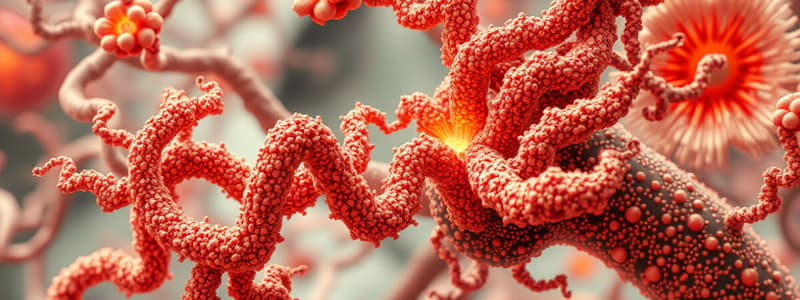Podcast
Questions and Answers
What does protein also play a critical role in?
What does protein also play a critical role in?
the function of many cells and enzymes in the body.
What are the names of some Essential Amino Acids?
What are the names of some Essential Amino Acids?
- Alanine, Asparagine, Tyrosine
- Methionine, Phenylalanine, Threonine (correct)
- Isoleucine, Leucine, Lysine (correct)
- Arginine, Histidine, Cysteine
What are some names of NONessential Amino Acids?
What are some names of NONessential Amino Acids?
- Isoleucine, Leucine, Methionine
- Phenylalanine, Threonine, Valine
- Lysine, Tryptophan, Glutamine
- Alanine, Asparagine, Aspartic Acid (correct)
What are the names of Semiessential Amino Acids?
What are the names of Semiessential Amino Acids?
What are examples of High Nutrient Density foods?
What are examples of High Nutrient Density foods?
What are some foods you should eat keeping portions in mind?
What are some foods you should eat keeping portions in mind?
What are some foods you should eat sparingly that are LOW nutrient density foods?
What are some foods you should eat sparingly that are LOW nutrient density foods?
What is the dietary reference intake or DRI for protein?
What is the dietary reference intake or DRI for protein?
What is new research showing regarding protein intake?
What is new research showing regarding protein intake?
What is a complete protein?
What is a complete protein?
What are foods that do not contain all of the essential amino acids in the amount the body needs called?
What are foods that do not contain all of the essential amino acids in the amount the body needs called?
What are examples of incomplete proteins?
What are examples of incomplete proteins?
What is an example of complementary proteins?
What is an example of complementary proteins?
What are some examples of complete protein food sources?
What are some examples of complete protein food sources?
In addition to carbohydrates and proteins, what else provides energy for the body?
In addition to carbohydrates and proteins, what else provides energy for the body?
What do lipids include?
What do lipids include?
What are lipids composed of?
What are lipids composed of?
What are fatty acids?
What are fatty acids?
Flashcards are hidden until you start studying
Study Notes
Role of Proteins
- Proteins are essential for the function of cells and enzymes in the body.
- Intestinal cells are replaced every 3 days; red blood cells last 4 months; skin cells are continuously renewed.
- Increased cell turnover due to illness or stress raises protein requirements.
Essential Amino Acids
- Key essential amino acids include:
- Isoleucine
- Leucine
- Lysine
- Methionine
- Phenylalanine
- Threonine
- Tryptophan
- Valine
Nonessential Amino Acids
- Common nonessential amino acids are:
- Alanine
- Asparagine
- Aspartic Acid
- Cysteine
- Glutamic Acid
- Glutamine
- Glycine
- Proline
- Serine
- Tyrosine
Semiessential Amino Acids
- Semiessential amino acids include Arginine and Histidine.
High Nutrient Density Foods
- Foods to prioritize intake:
- Non-starchy vegetables (raw leafy greens and solid green vegetables)
- Beans
- Fresh fruits
Foods to Eat with Portion Control
- Moderate portions of:
- Starchy vegetables
- Whole grains
- Raw nuts and seeds
- Fish
- Fat-free dairy
- Poultry
- Eggs
Low Nutrient Density Foods
- Foods to consume sparingly:
- Red meat
- Full-fat dairy and cheese
- Refined grains (e.g., crackers, chips)
- Oils and refined sweets (sugars, baked goods)
Dietary Reference Intake (DRI) for Protein
- Recommended intake: 0.8 grams per kilogram of body weight daily.
- Protein should constitute 10-35% of daily caloric intake.
New Research on Protein Needs
- Recent findings suggest higher protein needs for specific groups like the elderly and athletes.
- Recommendations include 1.2-1.7 grams per kilogram for athletes, varying by activity level.
- Many athletes naturally achieve adequate protein intake without meeting formal recommendations.
Complete Proteins
- Complete proteins provide all essential amino acids in adequate amounts and are easily digestible.
- Common sources: animal proteins (meats, eggs, dairy) and plant protein (soy).
Incomplete Proteins
- Protein sources lacking all essential amino acids are termed incomplete proteins.
- Examples include beans, legumes, grains, and vegetables.
Complementary Proteins
- Combining incomplete proteins can yield complete proteins.
- Classic example: Rice and beans together provide a complete protein via amino acid complementarity.
Sources of Complete Proteins
- Foods that are complete sources of protein include:
- Whole eggs
- Dairy products
- Meat and poultry
- Fish
- Combinations like rice and beans, peanut butter on whole wheat, and yogurt with granola.
Energy Sources in the Body
- In addition to carbohydrates and proteins, fats (lipids) are significant energy sources.
Components of Lipids
- Lipids encompass:
- Fatty Acids
- Triglycerides
- Phospholipids
- Sterols (including cholesterol)
- Most body fat exists as triglycerides.
Composition of Lipids
- Made up of Carbon, Hydrogen, and Oxygen, with a higher hydrogen atom count.
- Lipids provide about 9 calories per gram, almost double the 4 calories per gram from carbohydrates.
Fatty Acids
- Fatty acids are carbon chains with a carboxyl group at one end, facilitating water miscibility.
- Further details not fully stated in the notes.
Studying That Suits You
Use AI to generate personalized quizzes and flashcards to suit your learning preferences.




